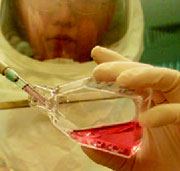|
by Bow HO and Vincent CHOW

 nfectious diseases have stricken humankind since time immemorial at a rate that has played out worst-case scenarios. The mycobacterial affliction of leprosy so feared during biblical times and severe acute respiratory syndrome (SARS) today serve as examples of scourges that have exacted a heavy toll. Infectious diseases are the leading cause of death worldwide and include tuberculosis, malaria, HIV/AIDS, dengue hemorrhagic fever, and influenza. Even though some previously epidemic infectious diseases have been controlled via widespread use of effective antibiotics and mass-immunisation programmes, new diseases invariably emerge and old ones resurface, and some of these have become drug-resistant. nfectious diseases have stricken humankind since time immemorial at a rate that has played out worst-case scenarios. The mycobacterial affliction of leprosy so feared during biblical times and severe acute respiratory syndrome (SARS) today serve as examples of scourges that have exacted a heavy toll. Infectious diseases are the leading cause of death worldwide and include tuberculosis, malaria, HIV/AIDS, dengue hemorrhagic fever, and influenza. Even though some previously epidemic infectious diseases have been controlled via widespread use of effective antibiotics and mass-immunisation programmes, new diseases invariably emerge and old ones resurface, and some of these have become drug-resistant.
Singapore constantly faces the double threat posed by such "old" infectious diseases as dengue and malaria, and such new ones as Nipah virus encephalitis and SARS. The Ministry of the Environment in Singapore operates a well established programme of epidemiological surveillance to monitor continuously any outbreaks of infectious disease (https://app10.internet.gov.sg/scripts/nea/cms/htdocs/category_sub.asp?cid=94).
|



 nfectious diseases have stricken humankind since time immemorial at a rate that has played out worst-case scenarios. The mycobacterial affliction of leprosy so feared during biblical times and severe acute respiratory syndrome (SARS) today serve as examples of scourges that have exacted a heavy toll. Infectious diseases are the leading cause of death worldwide and include tuberculosis, malaria, HIV/AIDS, dengue hemorrhagic fever, and influenza. Even though some previously epidemic infectious diseases have been controlled via widespread use of effective antibiotics and mass-immunisation programmes, new diseases invariably emerge and old ones resurface, and some of these have become drug-resistant.
nfectious diseases have stricken humankind since time immemorial at a rate that has played out worst-case scenarios. The mycobacterial affliction of leprosy so feared during biblical times and severe acute respiratory syndrome (SARS) today serve as examples of scourges that have exacted a heavy toll. Infectious diseases are the leading cause of death worldwide and include tuberculosis, malaria, HIV/AIDS, dengue hemorrhagic fever, and influenza. Even though some previously epidemic infectious diseases have been controlled via widespread use of effective antibiotics and mass-immunisation programmes, new diseases invariably emerge and old ones resurface, and some of these have become drug-resistant.